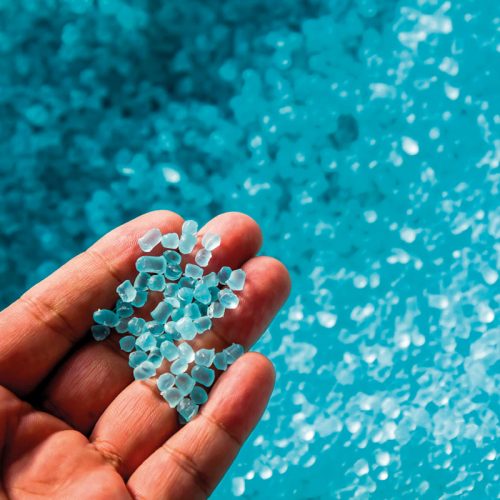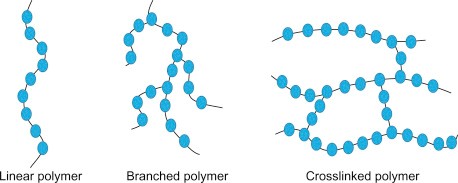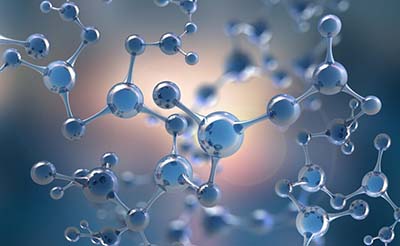
Polymer or large molecule or polymer are very large molecules that are formed by connecting several hundred monomers to each other and forming long chains. The word polymer has Greek roots and is composed of the word “poly” meaning several and “mer” meaning part or parts.
A monomer is the smallest repeating unit of a polymer. For example, if you consider a rosary as a polymer chain, the rosary beads are its monomers.
It is a process in which monomer molecules are joined together to form a large polymer molecule. Polymerization is the process of bonding monomers through a series of chemical reactions.
Polymers can be classified in different ways, the most common of which are as follows. Of course, polymers are divided into two types, engineering and common, depending on the type of construction and their application, and each of them is described in separate sections.
Plastics are divided into two categories in terms of heat behavior: thermoplastics and thermostats.

Thermoplastics: Thermoplastics or thermoplastics are polymers that are easily molded into various shapes by heat and then cooled and used at room temperature. That is, they soften when exposed to heat and harden again when cooled. Such as polyethylene, PVC, polypropylene, polystyrene, etc.
Thermoplastics consist of long chains, each of which may have groups or side chains. Thermoplastics do not undergo any chemical reaction during the process and their formation due to heat. Thermoplastics, when exposed to heat, can flow and easily take the form of various molds.
Thermostats: Thermostats or thermosets are hard, non-melting polymers against heat. These polymers do not soften due to heat and it is not possible to re-mold them. Thermostats are cross-linked polymers that cannot be reused.
In thermostatic resins, molecularly active groups form cross-links between molecules during the manufacturing process. These cross-links or so-called curing of the material do not allow the material to soften due to heat. Thermostats are usually supplied as semi-polymerized compounds or liquid polymer-monomer mixtures so that production units can finalize them and then bake them.
In other words, thermostats are cooked through methods such as heating or radiation, etc. The cooking process is irreversible due to the same cross-links mentioned. That is, when reheated, unlike thermoplastics, these materials remain solid until they begin to degrade.
The most important thermostats are phenolics, urea, melamine, epoxy, alkyds, polyesters, silicon and urethane.
Structurally, polymers are divided into three categories: linear, branched and cross-linked polymers.
Linear polymers: In this type of polymer, monomers are bonded together to form long chains. In this type of polymers, there are no side branches and their molecules are close to each other and usually their density, melting point and tensile strength are high. Such as HDPE and nylon
Branched polymers: These polymers have long and straight chains, but also have different side chains. As a result, their molecules are irregularly positioned and therefore have a lower density, tensile strength, and low melting point.
Polymers are divided into three categories in terms of chain arrangement and crystallinity: crystalline (crystalline), amorphous (amorphous) and semi-crystalline.
Crystalline: When polymer chains are arranged in a very regular and special shape, they form a crystal. A crystalline polymer has its molecular chains locked together in a regular manner, which is why they show high strength. For crystalline polymers, the melting temperature is defined. That is, at a certain temperature or temperature range, crystalline polymers begin to melt, denoted by Tm.
Amorphous: They are the opposite of crystalline polymers, meaning that the molecular chains are arranged randomly and irregularly and do not follow a specific shape. This makes them have high elasticity and flexibility. Unlike crystalline polymers, amorphous polymers do not have a melting point and show the temperature at which they flow in Tg or glass transition temperature. Important features of amorphous polymers are relatively low thermal resistance, low dimensional stability, relatively high creep.
Semi-crystalline: In fact, it can be said that all polymers have crystalline and amorphous regions at the same time. That is, there is no 100% amorphous polymer, especially 100% crystalline. However, there are ways to bring these values closer to 100. Usually amorphous polymers up to 90% and crystalline polymers up to 80% are amorphous and crystalline in nature.
Homopolymer: A polymer that has only one specific monomer and only that monomer is repeated in its chains. These types of polymers are called homopolymers, such as polyethylene (containing only ethylene monomer), polyvinyl chloride (containing only vinyl chloride monomer).
Copolymers: Copolymers are polymers that are composed of two different types of monomers and in their repeating units there are two types of monomers, such as nylon 66. If the number of available monomers increases to 3, they are called terpolymers such as ABS or acrylonitrile. Butadiene styrene
Polymers are divided into 4 categories in terms of application and physical properties: plastic, rubber or elastomer, fibers and resin.
Plastics: Polymers that have been converted to hard and rigid materials by heat and pressure are known as plastics and are mostly semi-crystalline. Like PMMA, PE, etc., their intermolecular force between fibers and tires.
Elastomers or rubbers: Solid polymers with good elastic properties and high elasticity. In this type of polymers, polymer chains are connected by the weakest intermolecular force and most of their structure is amorphous. This weak intermolecular force causes the properties of those above them. Like rubbers
Fibers: If a polymer is a long strand that is at least 100 times its diameter, they are called fibers. These polymers have very high tensile properties and show a high degree of crystallinity, like nylon.
Resins: are low molecular weight polymers that are used as adhesives, sealants, etc. Most are available in liquid form and are usually baked during or after use for extra strength. For example, adhesives used in general use harden after a period of exposure to the air. They are called air-based adhesives.
ISO Tactics: A head-to-tail configuration in which groups are all on one side of the chain is called an ISO tactic.

There are simple methods that can be used to identify the type of polymers. These methods include:
In the early stages, controlling the solubility of a polymer is a simple method that can be used to identify polymers. To do this, it is enough to mix 0.1 g of the desired polymer with 5 ml of special solvent in a test tube. Because some polymers take longer to dissolve, it is recommended that the sample be tested after several hours. In some cases, the test tube is heated to accelerate dissolution. The table below shows the solvent and insoluble materials for many polymers at room temperature.
As you know, the density of a substance is expressed in terms of mass to volume ratio and according to the following relation:
ρ = m / Vρ = m / V
The easiest way to determine the density of a polymer is to use flotation. This method involves immersing the polymer sample in a liquid of known density. For example, samples can be immersed in methanol, water, magnesium chloride saturated solution, or aqueous zinc chloride solution. The density of these materials is equal to 0.79, 1/00, 1/34, 2/1 with the unit g cm − 3g cm − 3, respectively.

The behavior of the sample can be observed below. In other words, whether the sample is placed on a liquid surface, immersed, or transferred to the bottom of a test tube can be examined. This special behavior indicates whether or not the polymer is denser than the liquid.
Heating polymers provides many basic methods for identifying them. The “flame test” can be used to identify polymers because the flame produced by the burning of polymers has different properties depending on the structure of the material. To investigate the behavior of a polymer against a flame, it is sufficient to place a small amount of the sample on a gentle benzene flame with a spatula. You should note the type, color and smell of the flame. The table below shows the flame test results for some polymers.
The behavior of “degradation of polymers” can be examined using the pyrolysis test. Thermal degradation produces particles that are normally flammable and have a specific odor. A polymer sample can be heated without direct flame exposure. To do this, you have to put a small sample of it inside the pyrolysis tube and with the help of tweezers, place it on the benzene lamp.
Place a pH paper or wet litmus paper at the bottom of the pyrolysis tube to identify the type of smoke. Acidic, alkaline or neutral properties can be used to identify polymers. The table below shows the different pH classifications in polymers.
The behavior of “degradation of polymers” can be examined using the pyrolysis test. Thermal degradation produces particles that are normally flammable and have a specific odor. A polymer sample can be heated without direct flame exposure. To do this, you have to put a small sample of it inside the pyrolysis tube and with the help of tweezers, place it on the benzene lamp.
Place a pH paper or wet litmus paper at the bottom of the pyrolysis tube to identify the type of smoke. Acidic, alkaline or neutral properties can be used to identify polymers. The table below shows the different pH classifications in polymers.

In thermoplastics, melting temperatures are used to identify polymers. Melting behavior in polymers can be investigated through a standard melting point tube or “hot-stage”. The second method, with the help of thermal resistors, provides a temperature gradient along the metal plate. We place small pieces of the sample directly on different parts of the metal plate. Melting temperature can be measured directly with the help of a hot plate. The melting temperature for some polymers is given in the table below:
1)
| پلیمر | حلال | غیرحلال |
| PE | هیدروکربنها | تمامی مایعات در دمای اتاق |
| PP | هیدروکربنها | اتیل استات |
| PVC | دیمتیل فرمامید، تتراهیدروفوران، سیکلو هگزانون، متیلاتیل کتون | استون، هیدروکربنها |
| PS | سیکلوهگزان، بنزن، متیلاتیل کتون، تولوئن | هیدروکربنهای آلیفاتیک، الکلها، استون |
| PMMA | بنزن، کلروفرم، استون، هیدروکربنهای آروماتیک | هیدروکربنهای آلیفاتیک، الکلها |
| نایلون | ام-کرسول، استون | هیدروکربنها، اتر |
| PAN | دیمتیل فرمامید | هیدروکربنها، الکلها، کتونها، اتر |
| استات سلولز | کلروفرم، استون | هیدروکربنها |
| PVA | متانول، بنزن، کلروفرم، استون | هیدروکربنهای آلیفاتیک |
| PVAI | آب، دیمتیل فرمامید، | هیدروکربنها، کتونها، متانول |
| PET | فنول | هیدروکربنها، استون |
| PU | فرمیک اسید، ام-کرسول | متانول، اتر، هیدروکربنها |
| لاستیک طبیعی (رابر طبیعی) | هیدروکربنها، هیدروکربنهای کلرزده، اتر | الکل، استون |
| PDMS | کلروفرم، بنزن، اتر | متانول، اتانول |
| پلیسیکلو پروپن | بنزن، کلروبنزن | هیدروکربنهای آلیفاتیک، الکلها، کتونها |
| SBR | بنزن، متیلاتیل کتون | الکلها |
| نیتریل رابر | بنزن | متانول |
2)
| پلیمر | رنگ | بو |
| PE | زرد، آبی | شمع سوزان |
| PP | زرد، آبی | شمع سوزان |
| PVC | زرد، سبز، دوده | تند |
| PS | زرد، آبی، دودهای | استایرن (بویی شبیه به بوی استایرن) |
| PMMA | زرد، آبی | شیرین |
| نایلون | زرد، آبی | – |
| PTFE | زرد | – |
| PAN | زرد | چوب سوخته |
| استات سلولز | زرد | استیک اسید و سرکه |
| نیترات سلولز | زرد | کافور |
| PU | زرد، آبی | تند |
3)
| pH 8.0−9.5pH 8.0−9.5 | pH 5.0−5.5pH 5.0−5.5 | pH 0.5−4.0pH 0.5−4.0 |
| نایلون | سیلیکون | رزین پلیاستر |
| PAN | PP | الاستومر PU |
| آمینو رزینها | PE | استات سلولز |
| رزین فنولیک | PS | نیترات سلولاز |
| ABS | رززین اپوکسی | PET |
4)
| پلیمر | دما (بازه ذوب) |
| PDMS | −54−54 |
| رابر طبیعی | 2828 |
| PVA | 35−8535−85 |
| کلوروفن | 8080 |
| LDPE | 115115 |
| PVDF | 115−140115−140 |
| UHMWPE | 120120 |
| PMMA | 120−160120−160 |
| PET | 160−170 |